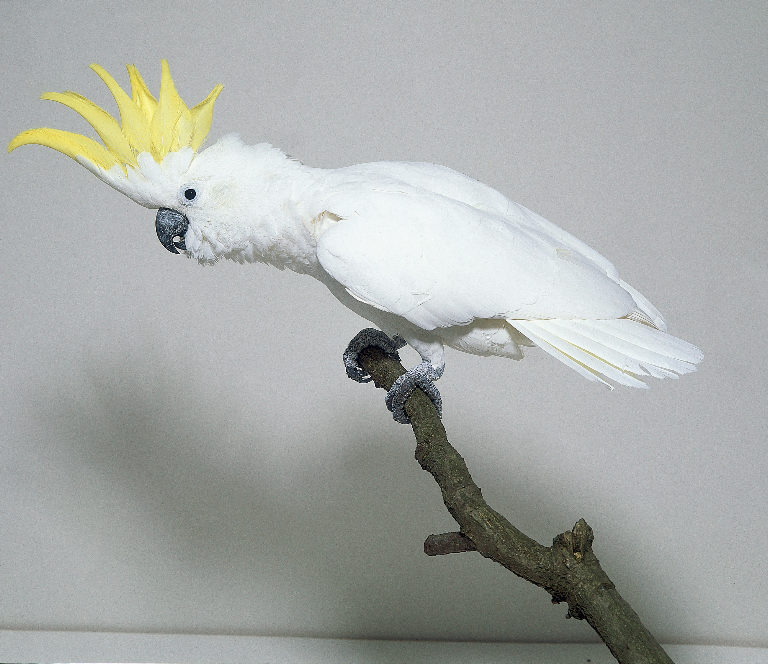
Sulphur-crested cockatoo(Cacatua galerita)
Phylum —chordata
Class — aves
Order — psittaciformes
Family — cacatuidae
Genus – cacatua
Appearance
Sulphur-crested cockatoos are 44–55 cm (17.5–21.5 in) long, with the Australian subspecies larger than subspecies from New Guinea and nearby islands. The plumage is overall white, while the underwing and -tail are tinged yellow. The expressive crest is yellow. The bill is black, the legs are grey, and the eye-ring is whitish. Males typically have almost black eyes, whereas the females have a more red or brown eye, but this requires optimum viewing conditions to be seen.
Habitat
The Sulphur-crested cockatoo is found in large numbers in the east and north of Australia and most of New Guinea with nearby smaller islands. It also lives in Western Australia, Singapore, Palau, Taiwan, Puerto Rico and New Zealand as an introduced species.
Behavior
This cockatoo is a diurnal gregarious bird, and flocks from a dozen up to several hundred will form. At sunrise they fly from the roosting grounds to feeding grounds, flying back to roost at dusk. They feed in groups, while one individual watches for danger from a nearby perch. They shelter in trees during the hottest times of the day. Their flight pattern is typically a series of quick, shallow wing beats with gliding in between. They fly to and from feeding grounds at considerable height, to swoop down in wide, sweeping circles. They are noisy birds and screeching is their main method of communication. They raise and spread their striking crests when danger threatens or during mating.
Diet
Sulphur-crested cockatoos are mainly herbivores in the wild, and will feed on the ground as well as in trees. They eat mainly seeds, nuts, blossoms, fruits, insects and insect larvae. Newly planted and ripening grains are another source.
Reproduction
These birds are monogamous, forming bonds that last a long time. In the north they breed from May until September, whereas in the south the season is from August to January. The usual nest is high in a tree hollow, most often near water. They breed once a year, when 2 to 3 white eggs are laid, to be incubated by both parents, for 27 to 30 days. Both parents feed the chicks. At approximately 70 days the chicks are ready to leave the nest but will stay with the parents, and family units will stay together indefinitely. Reproductive maturity for both male and female is around 3 to 4 years old.
Average lifespan is about 40 years, but they can live up to 100 years.
In captivity
Sulphur-crested cockatoos are large birds that need very spacious enclosures. At a minimum, the cage should have a footprint of about 40 inches by 40 inches and at least 5 feet tall. A bigger cage is better, and best of all is an aviary environment.
Bird bathing is strictly an individual preference. In the wild, some cockatoos enjoy standing in the rain while others avoid it.
The Sulphur-crested cockatoo is a highly active and lively bird that requires plenty of exercise to maintain proper health. Owners of Sulphur-crested cockatoos should allow their pets a minimum of 3 to 4 hours of outside-the-cage playtime every day.
Provide the bird plenty of space to climb, stretch, and flap its wings. Most cockatoo owners provide their birds with play stands or special perches for their exercise needs.
Give your cockatoo plenty of interactive toys that can be chewed, grasped, and climbed. Cockatoos have one of the most powerful beaks in the parrot world, expect to give them durable toys. Birds get tired of the same toys every day, plan to rotate them in and out to keep your bird interested and distracted from unwanted behaviors like chewing on your wooden furniture.
In the wild, Sulphur-crested cockatoos feast on seeds, grain, and insects that they harvest from trees. In captivity, they need a varied diet that includes high-quality pellets and fresh fruits and vegetables. Experienced owners of Sulphur-crested cockatoos take great care in preparing their birds' diets, as cockatoos can quickly suffer from the effects of poor nutrition.
A well-formulated, high-quality parrot pellet should account for 75 percent of its dietary needs. The remaining 25 percent should be fresh fruits and vegetables. Start by offering your bird 1/4 cup of pellets and 1/4 cup of fruits daily. Increase the amount as needed. Nuts and seeds can be given sparingly as training treats.
 Russian
Russian
 English
English























